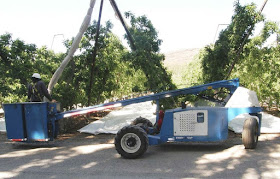Orchard worker using fall protection (full body harness with lanyard) while working from a powered platform to maintain an orchard shade cloth system
On May 6,
2015, a 29-year-old orchard laborer fell from the elevated basket of an aerial
lift and suffered a serious head injury.
The laborer
had five years’ experience working in orchards, two of which were with at his
employer’s orchard. He had received safety training relating to his job duties
from his employer.
During the
growing season, his full-time duties included maintaining the orchard shade
cloth system. Horizontal cable wires 17 to 20 feet high supported by poles
allowed cloth to be rolled out like a curtain to provide shade for trees.
He and other
employees worked to extend and roll up the shade cloth as well as maintain the
cable system that supports the cloth. On the day of the incident, the laborer
was using a three-wheeled aerial lift to access the shade cloth system in order to roll out the cloth.
He was
working from the lift’s elevated basket. He had previously operated this type
of lift. He was not using a fall protection harness with a lanyard attached to
the basket.
As he was
manually moving the shade cloth, the supporting cable wire snapped and knocked
him out of the basket. He fell 17 feet from the basket to the ground.
He was
knocked unconscious and taken to a hospital where he was diagnosed with a skull
fracture and a traumatic brain injury. He suffered numerous complications
related to his injury and was still unable to return to work more than a year
later.
Requirements
• The manufacturer’s instructional
manual, if any, must be used to establish the proper operational sequences and
maintenance procedures. If there is no manual, you must develop instructions.
The instructions must be available for reference by operators.
See WAC 296-307-27010(1)
• Only employees qualified by training or experience may
operate aerial manlifts.
See WAC 296-307-27010(3)
Recommendations
• Ensure that all persons on the
platform of boom supported elevating work platforms wear a body belt or full
body harness and lanyard fixed to the manufacturer provided and approved
attachment points to prevent workers from being ejected from the platform or in
the event that they do fall from the platform their fall will be arrested.
• Choose the appropriate fall protection system based on
the manufacturer’s specification or, if this is not available, on the type of
elevating work platform to be used and the work activity.
• A personal fall restraint system will prevent persons on
the elevating work platform from falling any distance. A fall restraint system
should be preferred over a fall arrest system whenever possible.
• A fall arrest system should allow workers to move around
the platform but provide a minimum of lanyard slack.


